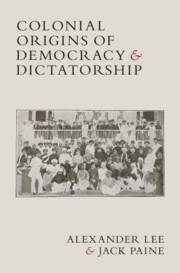457 results
15 - Elections and Voting
-
-
- Book:
- The Conservative Effect, 2010–2024
- Print publication:
- 27 June 2024, pp 466-507
-
- Chapter
- Export citation
4 - Imperial Expansion and Restrictive Elections: 1850–1945
-
- Book:
- Colonial Origins of Democracy and Dictatorship
- Published online:
- 08 May 2024
- Print publication:
- 30 May 2024, pp 90-127
-
- Chapter
- Export citation
2 - A Theory of Colonial Electoral Institutions
-
- Book:
- Colonial Origins of Democracy and Dictatorship
- Published online:
- 08 May 2024
- Print publication:
- 30 May 2024, pp 25-49
-
- Chapter
- Export citation
6 - Postcolonial Persistence
-
- Book:
- Colonial Origins of Democracy and Dictatorship
- Published online:
- 08 May 2024
- Print publication:
- 30 May 2024, pp 157-193
-
- Chapter
- Export citation
7 - Conclusion
-
- Book:
- Colonial Origins of Democracy and Dictatorship
- Published online:
- 08 May 2024
- Print publication:
- 30 May 2024, pp 194-206
-
- Chapter
- Export citation
5 - Mass Franchise Expansion after 1945
-
- Book:
- Colonial Origins of Democracy and Dictatorship
- Published online:
- 08 May 2024
- Print publication:
- 30 May 2024, pp 128-156
-
- Chapter
- Export citation
1 - Introduction
-
- Book:
- Colonial Origins of Democracy and Dictatorship
- Published online:
- 08 May 2024
- Print publication:
- 30 May 2024, pp 1-24
-
- Chapter
- Export citation
3 - Representation in Settler Colonies through 1850
-
- Book:
- Colonial Origins of Democracy and Dictatorship
- Published online:
- 08 May 2024
- Print publication:
- 30 May 2024, pp 50-89
-
- Chapter
- Export citation
2 - How Union Organizations Shape Teacher Mobilization
-
- Book:
- Mobilizing Teachers
- Published online:
- 16 May 2024
- Print publication:
- 23 May 2024, pp 13-34
-
- Chapter
- Export citation
7 - Movementism in Argentina
-
- Book:
- Mobilizing Teachers
- Published online:
- 16 May 2024
- Print publication:
- 23 May 2024, pp 131-152
-
- Chapter
- Export citation
1 - Why Teachers?
-
- Book:
- Mobilizing Teachers
- Published online:
- 16 May 2024
- Print publication:
- 23 May 2024, pp 1-12
-
- Chapter
- Export citation
9 - Leftism in Colombia
-
- Book:
- Mobilizing Teachers
- Published online:
- 16 May 2024
- Print publication:
- 23 May 2024, pp 171-191
-
- Chapter
- Export citation
The Power of Characters: Evaluating Machine Learning-Modified Bayesian Improved Surname Geocoding Inference of Race in Redistricting
-
- Journal:
- State Politics & Policy Quarterly ,
- Published online by Cambridge University Press:
- 22 May 2024, pp. 1-22
-
- Article
-
- You have access
- Open access
- HTML
- Export citation
Critical Forum: Populism, Hybrid Democracy, and Youth Cultures
-
- Journal:
- Critical Pakistan Studies ,
- Published online by Cambridge University Press:
- 20 May 2024, pp. 1-31
-
- Article
-
- You have access
- Open access
- HTML
- Export citation
Is political anxiety different than general anxiety?
-
- Journal:
- Politics and the Life Sciences , First View
- Published online by Cambridge University Press:
- 14 May 2024, pp. 1-9
-
- Article
-
- You have access
- Open access
- HTML
- Export citation
8 - Khameneism and the Absolute Velayat-e Faqih
-
- Book:
- How Islam Rules in Iran
- Published online:
- 02 May 2024
- Print publication:
- 09 May 2024, pp 264-296
-
- Chapter
- Export citation
7 - Legitimate Authority
-
- Book:
- How Islam Rules in Iran
- Published online:
- 02 May 2024
- Print publication:
- 09 May 2024, pp 238-263
-
- Chapter
- Export citation

Colonial Origins of Democracy and Dictatorship
-
- Published online:
- 08 May 2024
- Print publication:
- 30 May 2024
The rise of the Spanish right during the Second Republic (1931–36). Social structures, Catholic associations, and conservative electoral mobilization
-
- Journal:
- Social Science History , First View
- Published online by Cambridge University Press:
- 06 May 2024, pp. 1-30
-
- Article
-
- You have access
- Open access
- HTML
- Export citation
The study of Italian regional politics and the composition of the regional political class. The ITREGPARL dataset
-
- Journal:
- Italian Political Science Review / Rivista Italiana di Scienza Politica , First View
- Published online by Cambridge University Press:
- 30 April 2024, pp. 1-9
-
- Article
-
- You have access
- Open access
- HTML
- Export citation



